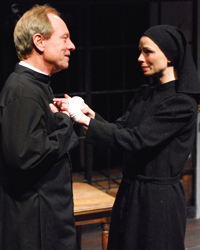From the Chicago Tribune
‘Mariette in Ecstasy’ a ripping good story
February 25, 2009
By Chris Jones
If “Mariette in Ecstasy” were not about nuns, you’d probably call it a bodice ripper.
But because this new Lifeline Theatre dramatization of Ron Hansen’s juicy but contemplative novel concerns the Sisters of the Crucifixion and an especially enigmatic postulate, this fusion of spirituality, shelter, stigmata and sexual tension needs a different moniker.
Let’s go with a really good yarn, grippingly told, forcefully acted and intellectually engaging.
Longtime fans of Lifeline know all about this tiny theater’s proven abilities with rich, accessible, truthful storytelling. But this richly surprising show throbs with especially complex life.
Christina Calvit – surely one of America’s best and most overlooked adapter of novels into drama – has taken a work of woman-centered, mainstream historical fiction and somehow negotiated the tonal sweet spot between truth and heightened romanticism.
When things get a little over-ripe in Hansen’s story of the underbelly of the cloisters, director Elise Kauzlaric gives the audience permission for the occasional tension-releasing laugh. And yet, at other moments, the production also captures the music and rhythms of the monastic life with both dignity and poetry. You never quite know which way things are going to go, and that gives this show, one of the best Lifeline productions I’ve seen, a genuinely seductive tension.
Despite its racy sexual subtext of a would-be nun who riles a hitherto quiet sisterhood, “Mariette” isn’t some kind of crude exploitation. On the contrary, Hansen’s novel (which is set in upstate New York in 1906) is a compelling look at what happens to a community when a passionate, attractive outsider enters its walls and starts seeming closer to Jesus than some of her more mundane sisters.
It also probes some of the tricky questions at the center of any spiritual quest. What do religious orders do with the sexual tensions of its young postulants? Do ecstatic experiences happen more often to those with a natural flair for the dramatic? Can nuns eradicate envy? What does religious devotion do to the natural ties of family?
All of those matters are up for examination in this piece. The production benefits greatly from a remarkable central performance from a beautiful and honest young actress named Brenda Barrie,Ö who manages to physically set herself apart from everyone else in the production and appear at once more sophisticated and more dangerous. It’s a tough, somewhat overwritten role – it could easily be overplayed – but Barrie negotiates the various pitfalls with natural skill, evoking the high-school or college peer you envied, despised and adored.
Her color is emphasized by the willingness of several of the other strong actresses in the cast (such as Katie McLean, Patrice Egleston and Elizabeth Olson) to vanish into their habits.
Almost. As this show makes abundantly clear, a throbbing part of every nun always beats outside.
From the Chicago Sun-Times
Barrie’s terrific work enhances stage miracle
February 25, 2009
By Hedy Weiss
While religious faith might never quite assume a perfect form (after all, human beings are innately imperfect creatures), a certain kind of perfection can exist in the theater. And there could be no better example of it than “Mariette in Ecstasy,” Lifeline Theatre’s world premiere stage version of the best-selling 1991 novel by Ron Hansen.
The production, flawlessly adapted by Christina Calvit and directed by Elise Kauzlaric with a mix of magic and grace, also serves as a major showcase for a phenomenal young actress, Brenda Barrie, whose portrayal of Mariette Baptiste, the beautiful young postulant who brings chaos to the Catholic convent she hopes to enter, is nothing short of wizardry – uncanny in its sense of truth, mystery and ambiguity.
Hansen’s story, which homes in on the true nature of faith (and its more flamboyant counterpart, wishful thinking), is set within the strict confines of the Sisters of the Crucifixion, a convent in early 20th century America.
And from the moment the smart, sensual, tremendously self-dramatizing Mariette arrives at the place — dressed in her dead mother’s wedding gown and attracting a procession of admirers along the way – we sense this will not be an easy transition either for this young woman or for the sisters, novices and priest whose orderly if suppressed lives she will quickly begin to upend.
On one level, Mariette is made for convent life, with her feverish passion, her grand imagination and her zealous love of ritual and mysticism. She also is a born actress – a young woman with a desire to reach some grand emotional high and a need to be exceptional and stand in a brilliant spotlight.
These qualities are absolutely antithetical to the suppression of pride so crucial to the religious calling. So when, with extraordinarily perfect timing, Mariette reveals her stigmata (the wounds of Christ) on Christmas Eve, there are, not surprisingly, those who are carried along on the miracle of it all.
There also are plenty of others who believe she is a fraud, and still others, like the priest, Pere Mariott (Brian Parry, who subtly hints at his attraction to Mariette), and Mother Saint Raphael, Mistress of Novices (Morgan McCabe in an exquisitely limned portrait), who doubt Mariette, even if deep down they hope she is the real thing.
Kauzlaric’s production, with a magnificently atmospheric set by Alan Donahue that suggests both the prisonlike severity of the convent and its pristine beauty, is infused with Gregorian chants, bits of Latin, surprising bursts of humor and an attention to ritual that creates an ideal sense of place. Music director Joseph Burt has even devised an inspired percussive symphony of daily tasks using the sounds of mortar and pestle, washboard and broom.
Every supporting role is played with exquisite individuality, with bursts of wit and wisdom from Patrice Egleston, Allison Cain, Melinda Polus, Janice O’Neill, Katie McLean, Sarah Goeden, Elizabeth Olsen and Sadie Rogers. As for Barrie, she is nothing short of transfixing in a role that demands just such a charismatic presence.
From Chicago Stage Review
March 4, 2009
By Venus Zarris
If it is true that “In beautiful things we see God’s glory,” then a glimpse of the divine can be found at Lifeline Theatre as their world premiere adaptation of Mariette in Ecstasy is truly a thing of beauty.
Consistently setting standards for exceptional adaptations and outstanding productions, Lifeline reaches new levels of dramatic complexity with this enticing offering. Striking on so many levels, Mariette in Ecstasy proves to be a compelling theatrical experience for both believers and non-believers alike.
This is Agnes of God stripped of the contemporary melodrama and device. Mariette enters the order of the Sisters of the Crucifixion filled with enthusiastic piety and charming grace. She is seen as a saint by some and suspect, in this sheltered vacuum, by others. Her fervor to commune with God, fueled by passionately divine visions and heavenly visitations, borders on mania. When she manifests the physical condition of stigmata, the order becomes polarized between devout belief and jealous suspicion.
Director Elise Kauzlaric is a master of atmosphere and dramatic levels. She compiles one of the year’s most engaging ensembles to deliver the unique story as well as surprises the audience with explosive humor, in the midst of the cloistered suppression. These endearing nuns are expectedly odd and unexpectedly funny.
But Mariette in Ecstasy is far from a light comedy, more so rather a chilling examination of the extreme manifestations of faith in the midst of the dichotomies of contradictory dogma. Alan Donahue designs a beautifully evocative set. Sarah Hughey’s lighting design adds haunting complexity to the plays darker moments. Tim Hill’s sound design is superb and Joseph Burt’s musical direction electrifies the production with exceptional a cappella offerings of the daily songs and prayers. The creation of the cloister’s collective heartbeat through the daily grind of their menial tasks is an ingeniously stylized addition to the visceral feel of the production and the brief, but well placed, use of the music of Dead Can Dance in the second act is perfectly chilling.
But it is the truly splendid cast that captivates, convinces and delights. Each and every actor delivers exceptional work with outstanding performances rendered by Sadie Rogers as Sister Genevieve. She strikes a childlike balance between precociousness and naiveté. Brenda Barrie creates an eloquently sweet and charismatically zealous Mariette, sustaining the mystery of the character and the story throughout. And Sarah Goeden practically steals the show as Sister Hermance, the oddly charming, genuinely vulnerable and at times explosively hysterical novice with particular affections for Marriete. She does, with a subtle facial expression or brilliantly timed line delivery, what entire improve troupes aspire to accomplish and she does this while maintaining the integrity of her sweetly strange character.
Christina Calvit’s adaptation of Ron Hansen’s novel is fascinating from start to finish although with subject matter this incendiary, a cast this powerful and a production this remarkably realized, the dramatic build and climax are noticeably inconspicuous. Still, Mariette in Ecstasy is an intriguing examination of the fine line between devout faith and possible mental illness and a uniquely beguiling production that is not to be missed.
From Windy City Times
March 4, 2009
By Mary Shen Barnidge
There are religious faiths that incorporate physical expression into their liturgies – Shakers, Beguines, the Mevleviya Sufis – as there are charismatic and Pentecostal congregations who embrace spontaneous theoleptic seizures hearkening back to ancient pagan worship. But the Roman Catholic church, historically, has been invested with considerable temporal, as well as spiritual, power – a position rendering it wary of individuals claiming special status in either realm.
So the Sisters of the Crucifixion are understandably puzzled when a recently admitted postulant to their humble order proceeds to undergo supernatural visions and the inexplicable hemorrhages called “stigmata.” Is Mariette a spoiled rich brat seeking attention? Is her excruciation a psychosomatic response to family conflicts? Is the upheaval she generates among the convent’s younger denizens rooted in adolescent competition over who will be acknowledged the most popular girl in the class? Or could this pilgrim’s disturbing manifestations be fueled by actual divine intervention? Most important, what is to be done about it?
The mysteries of a religion founded on a martyrdom cannot help but encourage a propensity to extravagant behavior. But playgoers will encounter none of the misogynistic clichés – shrieking, thrashing or rending of garments – associated with sexist views of women-in-groups at this Lifeline Theatre production. (This isn’t The Crucible, in other words.) Age and hormone levels may play a part in shaping the personalities of this sororal microcosm, but author Ron Hansen and adapter Christina Calvit are more interested in the social dynamic within this community whose devotion to serene contemplation is threatened by the prospect of sudden notoriety.
Director Elise Kauzlaric has assembled a dream-team cast of character actresses, led by the alluring Brenda Barrie, whose performance here, as in the recent Beauty On The Vine, conveys just the right proportions of youthful vulnerability and sly calculation to keep us undecided as to the source of Mariette’s self-sacrificing (or self-serving) zeal. As the flinty Mother Saint Raphaël, her chief adversary, Morgan McCabe likewise strikes a balance between skepticism and envy. Patrice Egleston’s icy Rev. Mother Céline and Brian Parry’s avuncular Father Marriott project a refreshing dignity in roles easily reduced to popular stereotype, while Alan Donahue’s scenic design and Tim Hill’s score of sacred music reflect both the severity and the sanctuary of the cloistered life to create a dramatic ambience inviting intellectual discourse for open-minded audiences of all sectarian persuasions.
From Chicago Free Press
March 12, 2009
By Web Behrens
An enthralling glimpse into an exotic other world, “Mariette in Ecstasy” plunges its audience into an early-20th-century convent, where the nuns’ strictly scheduled lives become plunged into excitement and turmoil when a young postulant experiences divine revelations.
In some ways, it seems to tread the same thematic ground as “Doubt,” the much-honored play-turned-film about deep questions rending a Catholic community. But there’s no alleged sin on the level of sexual abuse in Christina Calvit’s script (adapted from Ron Hansen’s novel). Given the great swath of gray in which this central mystery resides, along with its richer canvas of characters, “Mariette” proves to be the superior story.
Director Elise Kauzlaric, an ace artistic team and an excellent ensemble plunge us into the self-contained world of the Sisters of the Crucifixion. Although their habits obscure much of the actresses’ physical individuality, the members of the ensemble all turn in top-notch work, etching distinct personalities despite their nearly identical wardrobes. This is very much an ensemble piece, but there’s no denying that the luminous Brenda Barrie dominates in the title role.
It’s all precisely navigated on Alan Donahue’s perfectly rigid set, both spare and prison-like. Guided by musical director Joseph Burt, the nuns’ harmonies are strong and lush; meanwhile, dialogue-free interludes depict the monotony of priory life while indicating the passage of time. Everything conspires to prove, once again, that Lifeline Theatre consistently delivers some of Chicago’s finest stagecraft.
From Centerstage
February 26, 2009
By Sarah Terez Rosenblum
Based on the bestselling novel of the same name, “Mariette in Ecstasy” tells the engrossing story of Mariette (a luminous Brenda Barrie), a spiritually ambitious young newcomer to the Sisters of the Crucifixion. Although in all other ways humble, Mariette believes Jesus has, in answer to her prayers, chosen her to experience his pain and carry his burden. Although she is beloved by her community outside of the cloister, her steadfast belief and increasingly violent ecstatic episodes intrigue and confound the nuns. Eventually it becomes clear that whether worshipped or vilified, Mariette is a lighting rode for controversy, destined to irrevocably change the nunnery, maybe even the church as a whole.
Director Elise Kauzlaric’s mesmerizing vision is beautifully realized in part by virtue of Alan Donahue’s gracefully spare set and a strong, convincing cast. Standouts include the elegant Patrice Egleston (Reverend Mother Celine), game show-voiced Brian Parry (Pere Mariott), and the aforementioned Barrie.
Adapted by Lifeline theater ensemble member, Christina Calvit, the script, by turns numinous and wry, retains much of the novel’s lovely wording and most of its dramatic punch. Although lengthy, “Mariette in Ecstasy” doesn’t drag, rather, entranced by its philosophical musings – Where is the line between religious belief and hysterical audacity? How exactly does the church treat its saints? – one doesn’t feel ready for the last lyrical word to fade.
From Time Out Chicago
March 5, 2009
By Megan Powell
She arrives like a bride, fully swathed in filmy white, and her passion for Christ is not unlike that of a new wife in love. Newly initiated into the upstate New York convent of the Sisters of the Crucifixion, Mariette’s clearly different in a world that values moderation and where “secrets are impossible” – she’s enigmatic, if not wildly romantic. “The wind feels like hands,” she thrills, standing apart from the others.
That peculiar observation emblematizes Mariette’s compelling mysteriousness for the other nuns (uniformly portrayed by an outstanding ensemble with wit and skillfully etched detail), who end up in varying degrees of obsession with her – whether envy, possession, desire or loathing – and for us, viewing a play that’s a suspenseful and subtle inquiry on faith. Many questions are asked, and few answers are given, but satisfyingly so. Played by Brenda Barrie with gorgeous vitality constrained by delicate grace, Mariette is passionate – or is she hysterical? Devoted or opportunistic? Saintly or sensual?
The seamless collaboration among Hansen’s spare prose, Calvit’s adroit adaptation and Kauzlaric’s deft production (commendably stripped of any contemporaneity but flush with the sounds of the cloister – the rhythm of work and haunting refrains of chants) ponders the larger question of whether faith is fortified by community, tradition and structure, or by intensely personal experience. Mariette in Ecstasy loses some of its taut urgency as the story unfolds and sometimes borders on the melodramatic, but for a story centering on the ascetic life of nuns in cloister at the turn of the 20th century, its riches are plentiful.
From The Urban Coaster
March 6, 2009
By Laurie Grauer
Lifeline’s current production of “Mariette in Ecstasy” explores faith and skepticism through the experiences of nuns in a Medieval convent. Adapted by Christina Calvit, from Ron Hansen’s contemporary bestseller, it’s the story of Mariette Baptiste, who undergoes initiation to join the order of the Sisters of the Crucifixion.
According to Saint Augustine: “Faith is to believe what you do not see; the reward of this faith is to see what you believe.” As eloquent as that sounds, I side more with Oscar Wilde who wrote “Skepticism is the beginning of Faith.” How many of us could accept a strange occurrence as a miracle, even when the manner in which it unfolds follows suit with your spiritual beliefs? It’s the question at the heart of Mariette in Ecstasy.
The Sisters lead a quiet life of prayer and devotion until it becomes apparent that Mariette may have had a divine encounter. This shatters the Sisters’ unity and creates an air of conflicting acceptance, envy, idolatry and fear. And when nuns and priests start to question the possible presence of Jesus, you know there’s trouble.
Lifeline’s world premiere play is an absolute masterpiece. From the moment the audience steps into the theater, they are immersed in the world of the Sister’s holy order. Upon the stage sit high castle walls, a balcony, iron bars and a life-size depiction of Christ crucified. Scenic and props designer Alan Donahue left no stone unturned to bring this Medieval-style convent to life. Sound designer Tim Hill displays his imaginative brilliance as he recreates the cadence of the Sisters’ daily chores in musical beats.
The Sisters’ melodic Gregorian chants also fill the air thanks to the musical direction of Joseph Burt. Lastly, the costumes designed by Branimira Ivanova add an extra touch of authenticity. In her first production with Lifeline, stage manager Stephanie Ehemann has already created a theatrical experience that audiences will talk about for years to come.
Elise Kauzlaric and her cast do a wonderful job of bringing each sister to life. Each nun is complete with her own history, temperament, sense of humor and character development. There is not a single weak link in this chain of dynamic performers.
Brenda Barrie, who plays Mariette, is absolutely marvelous in her role. Through a display of raw emotion, she is able to create a divine world real enough that you’ll wonders if she is the only one who sees it. This is a rising star who should be watched.
Patrice Egleston is on point in her role as the loving yet emotionally distant prioress. Sarah Goeden’s dramatic facial expressions enable her to use her character, Sister Hermance, as a comedic foil even in the role’s creepier moments.
Finally, Brian Perry, with his deep baritone voice, breathes much life into the priest Pere Mariott.
See this production. You will laugh, wonder what you have seen, and question what you believe. This will surely be a competitor for award nominations to come, so get your tickets while they’re still available to be had.
From NewCity
February 23, 2009
By Lisa Buscani
RECOMMENDED
In Lifeline Theatre’s “Mariette in Ecstasy,” postulant Mariette Baptiste (Brenda Barrie) joins the Sisters of the Crucifixion as a minor celebrity; her initiation is greeted with pageantry by townspeople. When she experiences what may be a divine encounter, she shatters the group’s fragile order. Is she God’s chosen or an attention-seeking poseur?
Christina Calvit’s adaptation of Ron Hansen’s best-selling novel initially fails to dramatize the cost of an ecstatic experience. The first act is cluttered by exposition; conflicts are alluded to and never resolved. But the ensemble captures the struggle of the faithful as they seek God, and the doubt and pain created by an “answer.” Barrie quietly depicts Mariette’s fiery religious passion; Sarah Goeden’s unrequited devotion to Mariette is heart-wrenching. Elise Kauzlaric’s direction effectively establishes the order’s punishing routine and pushes the performers to delve deeply into the characters on Alan Donahue’s spare yet vivid set.
From Steadstyle Chicago
March 2, 2009
By Alan Bresloff
Lifeline Theatre is presenting Christina Calvit’s adaptation of Ron Hansen’s best selling novel “Mariette in Ecstasy,” a story that deals with mystery and miracle in the cloister of The Sisters of the Crucifixion. These sisters live quiet lives filled with prayer and devotion with very little change from day to day until a new Postulant comes to them. Mariette comes to the Cloister because she believes that Jesus has asked her to join him there. Her sister, Reverend Mother Celine (played by Patrice Egleston) some 20 years her senior has concerns as to the true motives of her sister leaving her father behind to join them, but makes her feel at home.
The other Novices are intrigued by her, feeling that she is someone special and then a strange event takes place, a truly divine encounter that changes the lives of all of the residents of the Cloister. No longer are they a “family”, united as one. They now experience the same feelings that we all do (envy, hate, fear), challenges that cause them to think about their faith and the desire to find deeper meaning in their own souls and choices.
This is a powerful production with a solid cast of players. Mariette is played by Brenda Barrie, who is strikingly beautiful and radiates the aura that supposedly has been cast upon her. Director Elise Kauzlaric uses the stage at Lifeline to the best advantage on a marvelous set by Alan Donahue. This is a small and intimate theater but they are able to make the scene change from one area to another with just moving one piece that serves as a bed, a bench, a hospital bed and by the movement of the actors. This keeps the flow of the action moving which is important to the pace of the action. Too many pauses could break the mood. Well done!
The three novices (Elizabeth Olson, Sarah Goeden and Sadie Rogers) are young and adorable and do some heavenly chanting. There are several spots where the entire cast does chants and the harmony is wonderful and very spiritual. Joseph Burt’s music adds to the flavor and the lighting by Sarah Hughey creates the mood. Brian Parry handles the role of the Priest with the same expertise as you find in any role he plays. He is a master technician at character creation.
Shole Milos plays Dr. Baptise, Mariette’s father and the ensemble of Nuns (Melinda Polus, Janice O’Neill, Allison Cain and Morgan McCabe) are just perfect. This is an intense story with some thought-provoking action. Not being a Catholic myself, I wasn’t sure if this type of event could be thought to be true, but in speaking with some audience members, they tell me that there are people who truly believe in miracles of this nature. No matter your religion, this is a stirring story and a sterling production.
From chicagocritic.com
February 24, 2009
By Tom Williams
Lifeline Theatre specializes in adapting novels for the stage. Their latest, Ron Hansen’s 1991 contemporary bestseller, Mariette in Ecstasy, is a religious mystery that deals with the possibility of a miracle occurring. Hansen deftly builds his story, first by vividly presenting the life in a cloister than weaving Mariette’s (Brenda Barrie) journey from postulant to possible sainthood? We see Mariette as charismatic, devout, zealous young woman dedicated – fixated – on living her life in complete devotion to Christ. It is 1906 in upstate New York when Mariette joins The Sisters of the Crucifixion led by Mariette’s older sister Reverend Mother Celine (Patrice Egleston). We see how the sisters live quiet simple lives of work, prayer and devotion.
The novices take to Mariette while the older sisters are split over her commitment. Is she a sweet zealous believer or an attention seeking child? When she has an experience that results in a bloody stigmata, Father Pere Mariott (Brian Parry) becomes quizzical yet open minded. He investigates. Is Mariette’s trauma truly a divine encounter or a hoax? Christina Calvit’s adaptation offers a balanced treatment fueled by director Elise Kauzlaric’s fast-paced direction. The cloister’s harmony and unity is threatened by the debate over the validity of Mariette’s experiences. The nuns experience envy, idolatry and a subtle sexual attraction in regards to Mariette. The tension builds nicely in this production.
Mariette’s wounds appear to be real yet they bleed little and heal in one day. Did she really hear the voice of Christ? The play leaves enough for doubters to rationalize and believers to accept. Fanatics, believers and skeptics will debate the merits of the play.
Lifeline Theatre’s production is marvelous from the church-like set (designed by Alan Donahue) to the religious songs and Latin prayers. Our glimpse into cloister life and devotion is realistically presented. Brenda Barrie is a joy to watch as Mariette as she possesses a glow of contentment that focuses on complete honesty. She maintains a constant manner that shields the mystery of her stigmata. Did she really have a miraculous experience or was she an attention seeking fake? You be the judge.
This is fine ensemble work that features nice performances from Patrice Egleston, Brian Parry, Morgan McCabe and Elizabeth Olson. This is an outstanding theatrical achievement that quite effectively unfolds as a mystery and a character portrait. The effects one’s beliefs can have over their physical and psychology make up is dramatically depicted. Mariette in Ecstasy is one of the finest shows mounted in Chicago this year! Don’t miss it – Lifeline Theatre continues superb work.
From ShowBiz Chicago
February 26, 2009
By Michael J. Roberts
Lifeline Theatre, one of Chicago’s most innovative and risk taking ensemble companies, has created an intriguing and thought provoking production in the adaptation of Ron Hansen’s 1991 bestselling novel, Mariette In Ecstasy.
Ecstasy explores the phenomenon of stigmata (marks resembling Christ’s wounds appear on an individual’s hands) and the effect it has on a community of nuns, evoking some most unholy of reactions. The plot unfolds in 1906 where 17-year-old Mariette Baptiste enters an upstate New York convent. She is the daughter of a wealthy doctor and sister of the prioress, Mother Celine. Her beauty, intense devotion, and asceticism set her apart from the other nuns who are all highly conscious of fighting the sin of pride. While her sister is dying of cancer, Mariette experiences Christ’s wounds. The priest who hears confessions at the convent respects her humility and her astonishment at the miracle. But others in the convent are jealous. When villagers want to see the stigmata, the new prioress realizes that Mariette has become a threat to the organization, poverty, and discipline of the community. She sends Mariette home in an effort to protect her own authority.
Working with a smart, no nonsense adaptation by Christina Calvit, director Elise Kauzlaric has assembled an incredibly competent cast anchored by the Jeff worthy performance of Brenda Barrie who gives both a physically and psychologically nuanced interpretation of Mariette. Throughout the production, Barrie has a uncanny ability to separate herself from the other nuns in such subtle ways that when she is on stage, all eyes are focused on her actions. There is also a fantastic chemistry between Barrie and Patrice Egleston who plays her sister/Prioress. Both actresses, through the eyes of Kauzlaric, sees the physical transformations of their characters, one by faith and one by illness, as subtle yet heart wrenching.
Each actress brings a unique character trait and immense personality to their roles, which is not an easy task when all but their eyes, nose and mouth are visible. The two male actors of the piece, Shole Milos (Dr. Claude Bapiste) and Brian Parry (Pere Mariott) gives the story a nice juxtaposition of male authority and proves just how subordinate, both in eyes of society and religion women were treated at the turn of the century.
Married with the first rate acting is the unique environment the technical team at Lifeline has created for the Nuns to inhabit. Scenic designer Alan Donahue has build a dramatic, multi-tiered set, with winding staircases fronted by jail cell bars. Sarah Hughey’s lighting design augments the set magnificently, at times casting haunting shadows, while in an instant, changing into a type of interrogation spot when the ‘inquisition’ of Mariette is conducted. Not as noticeable, but much appreciated is Tim Hill’s sound design, where he uses hallowed echoes to signify the cavernous chambers of the Sisters’ nunnery and becomes quite a powerful device during the chants, expertly guided by musical director Joseph Burt.
As with any adaptation, there are some development details from the novel that would better round out the characters. Most importantly, Calvit gives little background on the father-sister-sister relationship which is a bit more flushed out in the novel. That background creates a greater emotional effect on Mariette when her sister passes away. Hanson, as in his other novels, also makes society an essential character in Ecstasy, which is taken a bit for granted on stage. Whether intentionally or by accident, Calvit’s stage adaptation closely follows the 1996 film screenplay (which featured Eva Marie Saint and John Mahoney). The play and film’s ending is much more abrupt then the novel, leaving the audience a little unsatisfied with the ultimate columniation of events. Not to say that everything should be wrapped up in a nice little package, but dare I say, by the end of the Lifeline’s Mariette in Ecstasy, you may be sensing a lot of… doubt.
From Copley News
February 24, 2009
By Dan Zeff
CHICAGO – Plays about intense religious experience need to tread carefully, avoiding sensationalism, preaching, or mockery. It’s a delicate subject, which makes the Lifeline Theatre’s absorbing production of “Mariette in Ecstasy” all the more rewarding.
The Lifeline’s master adapter Christine Calvit has re-created Ron Hansen’s 1991 novel for the intimate Lifeline stage, where it is receiving its world premiere. It would be no surprise if this play found a healthy afterlife in regional theaters across the country following its Lifeline run. The show might even gain acceptance in the tough-minded New York theater scene with the proper sensitive staging.
Hansen sets his story in a rural upstate New York religious community for women called the Sisters of the Crucifixion. The year is 1906. The community is isolated from the outside world, existing in its own world of prayer, hard work, and daily routine. The tightly knit community has its share of gossip and jealousies, and there is a hint of subliminal lesbianism that channels itself into religious fervor.
Fracturing the quiet and regulated community life is the appearance of attractive 17-year old Mariette Baptiste. Mariette seeks to become a nun. From the outset she shows a heightened love of Jesus Christ, claiming that Jesus has often talked to her in the past. In the eyes of some of the nuns, Mariette is a model of piety worthy of adoration. In the eyes of the more skeptical and envious sisters, she is a transparent example of religious hysteria or pride.
As Mariette divides the convent into opposing camps, the internal conflict is intensified by the appearance of the stigmata on Mariette’s hands and body. The play then becomes a kind of mystery story. Are the stigmata genuine miracles or a hoax perpetrated on the community by Mariette for unknown reasons? The girl seems sincere and the wounds on her hands and body heal as spontaneously as they appear. If Mariette is a fraud, she’s a remarkably ingenious fraud.
The issue of the stigmata doesn’t arise until the second act. Until then, the play is largely a collection of character portraits of the religious community as the nuns go about their prayers and chores in an unbroken lifestyle that may be tedious and arduous but provides comfort and structure to the lives of the sisters.
To its credit, the play and the novel offer no facile answers to the questions it raises about Mariette’s stigmata and the authenticity of her devotion. At the end, Mariette is sent away from the convent into the everyday world not because she may be a deceiver but because she is a disrupter. The girl departs with regret but not bitterness, the veracity of her religious experience unresolved.
The play introduces the audience to nine members of the community, plus the community’s priest. The nine women each have sharply etched distinctive personalities. The three novices, played by Sarah Goeden, Sadie Rogers, and Elizabeth Olson, are young and girlish, almost like giggling members of as college sorority instead of the rigorous Sisters of the Crucifixion. The sisters cover the spectrum from hardheaded realists who harbor serious doubts about Mariette and her “miracles’ to women eager to believe in miracles and the sanctity of Mariette’s belief.
The Lifeline ensemble performs superbly under Elise Kauzlaric’s sensitive but unobtrusive directing. Each actor locates the individual personality of her character with spot-on accuracy, not an easy task when the actresses blend together in their identical garb of black for the novices and white for the sisters.
The company casts Brenda Barrie in the central and difficult role of Mariette. Barrie plays the teen-ager with persuasive understatement and modesty. It’s difficult to believe her Mariette is a trickster or a hysteric but there is such subtlety and depth in her performance that the matter remains open ended, and properly so.
In addition to the novices, the sisters are played by Patrice Egleston as the current prioress and Mariette’s older sister, Morgan McCabe as the former prioress, and Melinda Polus, Janice O’Neill, Kate McLean, and Allison Cain as the other sisters. There is a fine humane performance by Brian Parry as the community’s priest and Shole Milos plays Mariette’s doctor/father, a worldly man who attempts to explode his daughter’s presumed “miracles.’
Alan Donahue has created an effective multi-level set that admirably establishes the various spaces within the convent. Branimira Ivanova designed the authentic-looking religious costumes and Sarah Hughey the complex lighting plan. Tim Hill is the sound designer and Joseph Burt is the musical director responsible for the splendid Gregorian chant singing by the ensemble.
“Mariette in Ecstasy” takes its place in the canon of other twentieth century plays and films that explore supernatural religious experience, like “Saint Joan,” “The Song of Bernadette,” and “Agnes of God.” It’s a play of warmth, sympathy, humor, suspense, and humanity. Well done all around.
The show gets a rating of four stars.



















